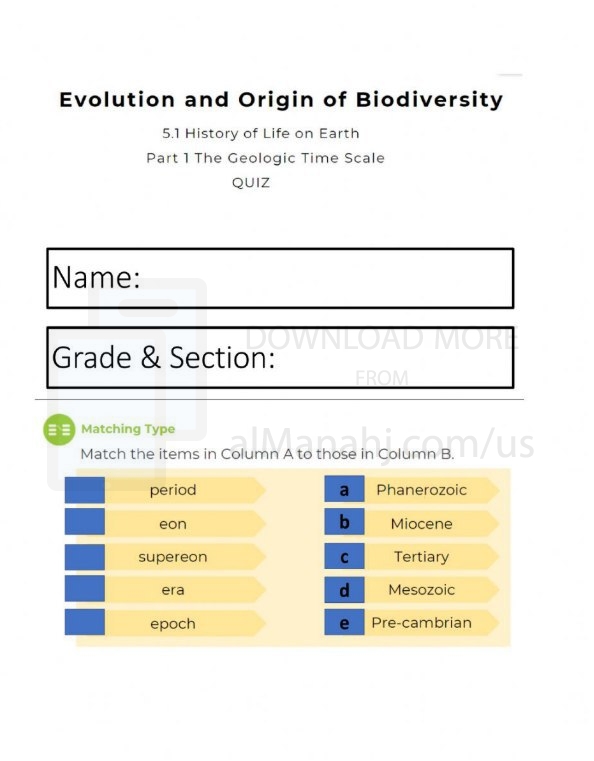| You are here: Almanahj Website ⇒ American curriculum ⇒ 12th Grade ⇒ Geology ⇒ Term 1 | ||
|---|---|---|
Worksheet about History of Earth | ||
|---|---|---|
| Subject: Geology | ||
| 12th Grade | ||
| Term 1 | ||
| Year: 2023/2024 | ||
| Size: 505.7KB | ||
| Number of clicks: 347 | ||
| Publish date:November 26, 2023 | ||
| Added by: Eman | ||
| Last download date: 2024-09-13 07:46:45 | By: theodor bilumin | |
| File info: The history of Earth spans approximately 4.6 billion years, and it is divided into different geological eras and periods. Here is a broad overview of the Earth's history: 1. Hadean Eon (4.6 billion to 4 billion years ago): The Hadean Eon represents the earliest period of Earth's history. During this time, the Earth formed from the accumulation of dust and gas in the solar nebula. The planet was characterized by intense volcanic activity, frequent impacts from asteroids and comets, and a very hostile environment. 2. Archean Eon (4 billion to 2.5 billion years ago): The Archean Eon marked the beginning of life on Earth. Simple, single-celled organisms, such as bacteria and archaea, emerged in the oceans. The Earth had a reducing atmosphere with little to no oxygen. 3. Proterozoic Eon (2.5 billion to 541 million years ago): The Proterozoic Eon saw the development of more complex life forms, including the first multicellular organisms. Oxygen levels in the atmosphere began to rise due to the photosynthetic activity of cyanobacteria, leading to the Great Oxygenation Event. 4. Paleozoic Era (541 million to 252 million years ago): The Paleozoic Era is characterized by significant evolutionary events. Marine life diversified, and the first plants, fungi, and animals colonized the land. The era witnessed the emergence of fish, insects, amphibians, reptiles, and eventually the first land-dwelling vertebrates, such as early dinosaurs. 5. Mesozoic Era (252 million to 66 million years ago): The Mesozoic Era is often referred to as the "Age of Dinosaurs." It saw the dominance of dinosaurs in terrestrial ecosystems and the emergence of birds and mammals. The end of the Mesozoic Era was marked by a mass extinction event, most notably the extinction of dinosaurs, possibly caused by a large asteroid impact. 6. Cenozoic Era (66 million years ago to present): The Cenozoic Era began with the recovery from the mass extinction event and is the current era. Mammals underwent significant diversification and eventually became the dominant terrestrial animals. It is during this era that humans evolved and rapidly developed complex civilizations. Throughout the Earth's history, there have been numerous climatic changes, geological events, extinctions, and evolutionary milestones. The study of Earth's history involves fields such as paleontology, geology, and stratigraphy, which provide insights into the past through the examination of fossil records, rock formations, and other geological evidence. | ||
| Downloading link Worksheet about History of Earth |
|---|
|
1701009937.pdf
The file is being prepared for download
|
| File images |
|---|
 |